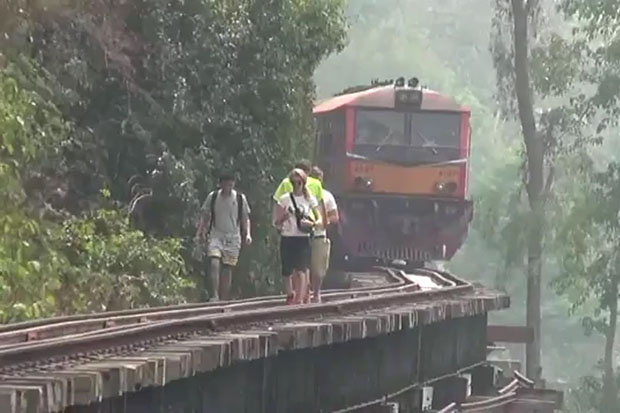
The State Railway of Thailand (SRT) will complete the maintenance of the seven-decade-old Death Railway from Ratchaburi to Kanchanaburi this June, with its signature wooden bridge preserved.
Somkid Noinarin, the SRT's railway maintenance inspector in Kanchanaburi, said on Monday that the task covered a 126-kilometre-long section of the railway — from the Nong Pladuk junction station in Ratchaburi province to the Nam Tok station in Kanchanaburi. Worn sleepers and tracks were replaced.
Rails weighing 70 pounds per yard were replaced with 100-pound ones. Worn wooden and concrete sleepers were replaced with new prestressed concrete sleepers. Bigger railroad switches were installed and track foundations were strengthened, he said.
The task would not only ensure safety but also result in smoother and faster travel — from the present speed of 40 kilometres per hour to 90kph, Mr Somkid said.
The maintenance was 96% completed pending the installation of new railroad switches at the Kanchanaburi train station, which should be finished on June 17, he said.
The work also covered the famous 335-metre-long wooden Tham Krasae Bridge which boasts the most beautiful view and biggest safety challenge of the Death Railway. The bridge goes parallel with a cliff on one side and overlooks a valley and the Kwai Noi River on the other.
Trains running on the tourist-oriented route must slow down on the bridge for safety because it is supported by its original wooden structure built over 70 years ago.
Half the original wooden sleepers on the bridge were replaced with new wooden sleepers and pieces of the wooden supportive structure were replaced with new wooden parts in order to keep the original wooden aspect of the section, Mr Somkid said.
Following an incident of huge rocks falling from the cliff onto the Tham Krasae section in February, Mr Somkid said that workers were installing protective nets in risky areas.
The Death Railway, stretching for 415km from between Ban Pong in Ratchaburi and Thanbyuzayat in Myanmar, was built by Japan in 1943 to support its forces in the Burma campaign of World War II. Around 304km of the railway was located in Thailand.
The railway completed the railroad link between Bangkok and Yangon in Myanmar. The line was closed in 1947, but the section between Nong Pla Duk and Nam Tok was reopened 10 years later in 1957.
Forced labour was used in its construction. More than 100,000 Asian labourers and Allied prisoners of war died during the construction.